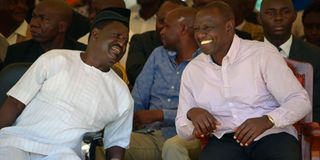The power of political rhetoric in winning voters' hearts

ODM leader Raila Odinga (left) and Deputy President William Ruto during a past function in Kisumu.
What you need to know:
- William Ruto has put his bet on Bottom-up hustlernomics and Raila Odinga on Pro-poor policies.
- To analyse this Kenyan political rhetoric, we need to focus closely on the content and form, what is being said and how it is being said.
History knows no political leader that has ever won people’s hearts and risen to power without a powerful political rhetoric. Presidential aspirants William Ruto and Raila Odinga have finally developed their political rhetoric for their political presser.
And while some leaders may sell genuine rhetoric, some are intentionally misleading, while others are misinformed rhetoric. Ruto has put his bet on Bottom-up hustlernomics and Raila on Pro-poor policies, building on urban regeneration strategy of President Uhuru Kenyatta.
Political rhetoric that puts the masses against people of class is nothing new. In Uganda, Amin ordered all Asians who had not taken Ugandan nationality to leave the country in 1972. The move won considerable approval because many Africans believed they had been exploited by the Asians, who controlled the economy, but the action isolated Uganda from the rest of the world.
Although a few wealthy Ugandans profited from Amin’s actions, the majority of the enterprises formerly owned by Asians were given to senior army officers who squandered the proceeds and allowed the businesses to collapse. This was a genuine but misinformed political rhetoric as Amin had little Western-style education and virtually no officer training.
In 2000, Robert Mugabe shocked the world when he made dramatic changes to land ownership laws in Zimbabwe, which saw thousands of white Zimbabwean farmers being forced to give up their farms and many to leave the country. While it is true that those white farmers owned 70 per cent of the most arable land, the move, though popular among the masses then, was not a smart move.
Populist rhetoric
The country that was once dubbed “the breadbasket of the region” suffered an estimated $12 billion in lost agricultural production since the land occupations took place and had to rely on donor handouts and food imports.
At least 1.8 million tonnes of maize is required annually to feed the nation. This was intentionally misleading rhetoric since Mugambe was one of the most academically decorated African leader.
In Tanzania, President John Pombe Magufuli’s presidency was seen as liberating and transformative especially in its infancy. Until the real impact of his populist approach started stinking, particularly his handling of the coronavirus pandemic and civic and political rights.
He reversed the gains made by President Benjamin Mkapa. A lot can be said about his leadership, but President Magufuli had good intentions for the country, but he was quite naïve that his approach could work. In that regard, his populist rhetoric was a genuine rhetoric that was counterproductive.
How then do we categorise the genuine political rhetoric, the intentionally misleading from misinformed one in Kenya? This is no mean task since political rhetoric in modern Kenya has some inherent complexities; the sheer number of speakers, quantity of information, diversity of viewpoints, variety of candidates and issues clamouring for our attention, the impact of the digital age, and the growing sophistication of modern persuasion techniques.
In every Kenyan election period, thousands of claims, charges, promises and threats by politicians and professional persuaders, advocates and amateurs are broadcast to millions of Kenyans.
Ruto's double-speak
Some, overwhelmed by the chaotic blitz, drop out completely, justifying their position with universal attacks: its all lies, its all phony promises anyway. Another common response is that Kenyans take sides too early (often based on their tribal positions), ignoring everything which doesn’t fit into their preconceived tribal notions.
Others get disgusted that “politicians are always arguing”, reformers “always complaining about something”. Such attitude doesn’t recognise that the conflict is essential for democracy, where different values and viewpoints are allowed.
To analyse this Kenyan political rhetoric, we need to focus closely on the content and form, what is being said and how it is being said. While this may seem obvious and self-evident, it’s seldom done. Most Kenyan political discussions are characterised by randomness and lack of coherence as people switch from one topic to another.
In that regard, it is easy to identify double-speak by analysing content. To analyse the two main political rhetorics, we need to assess the level of double-speak and how it is said to different classes. When the Deputy President meets what he calls dynasties and asks them to support his candidature, you see double-speak and realise it’s intentionally misleading.
It cannot be cannot be genuinely misinformed rhetoric since the Deputy President is a well-educated man. He has a PhD and is among the best communicators in the history of Kenyan politics.
If Raila gets to the details of how to execute his pro-poor strategy, we shall also assess his genuineness.
Dr Ogola is Academic Director - MBA programmes and Director of the Institute of Strategy and Competitiveness at Strathmore University





